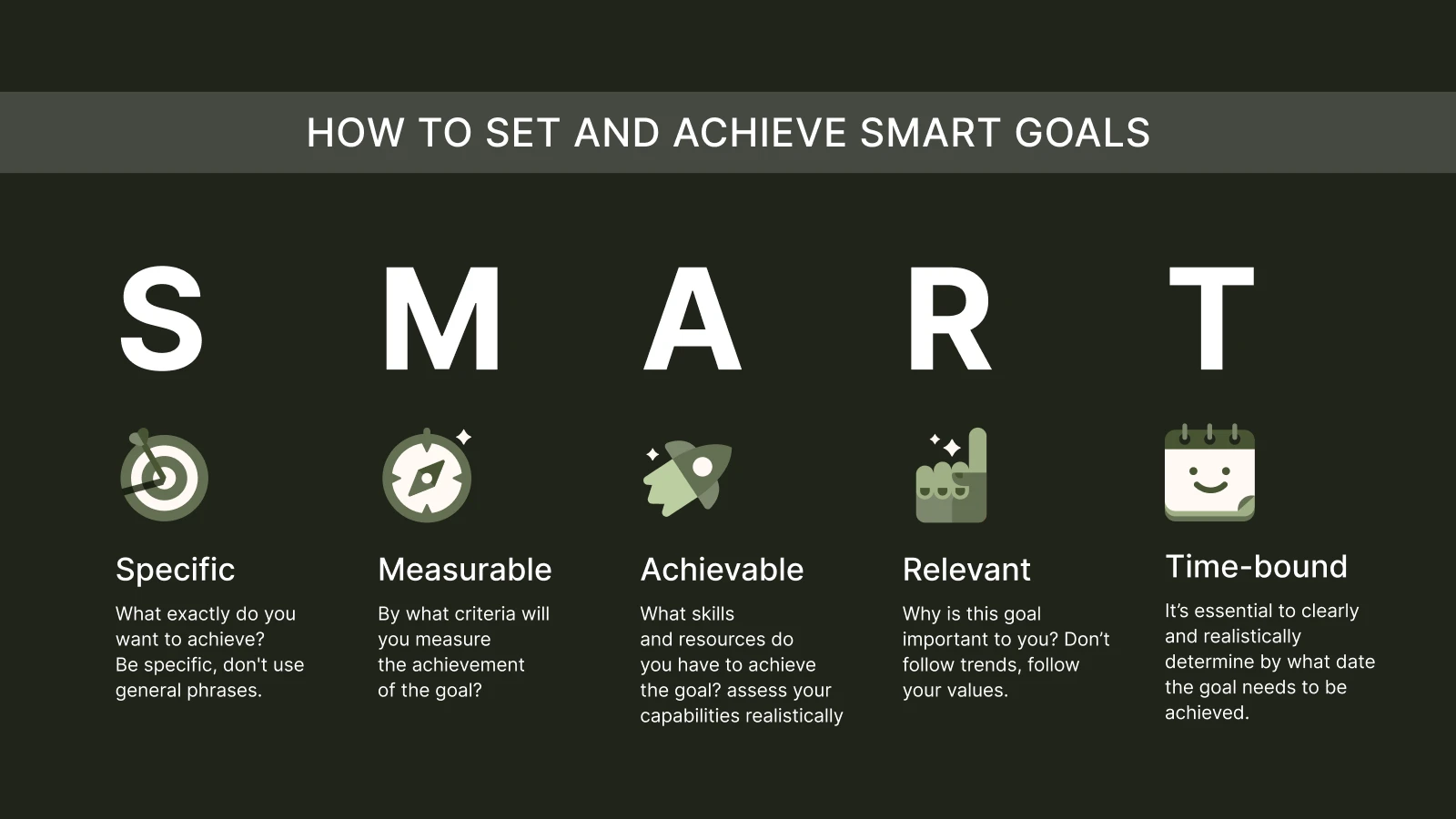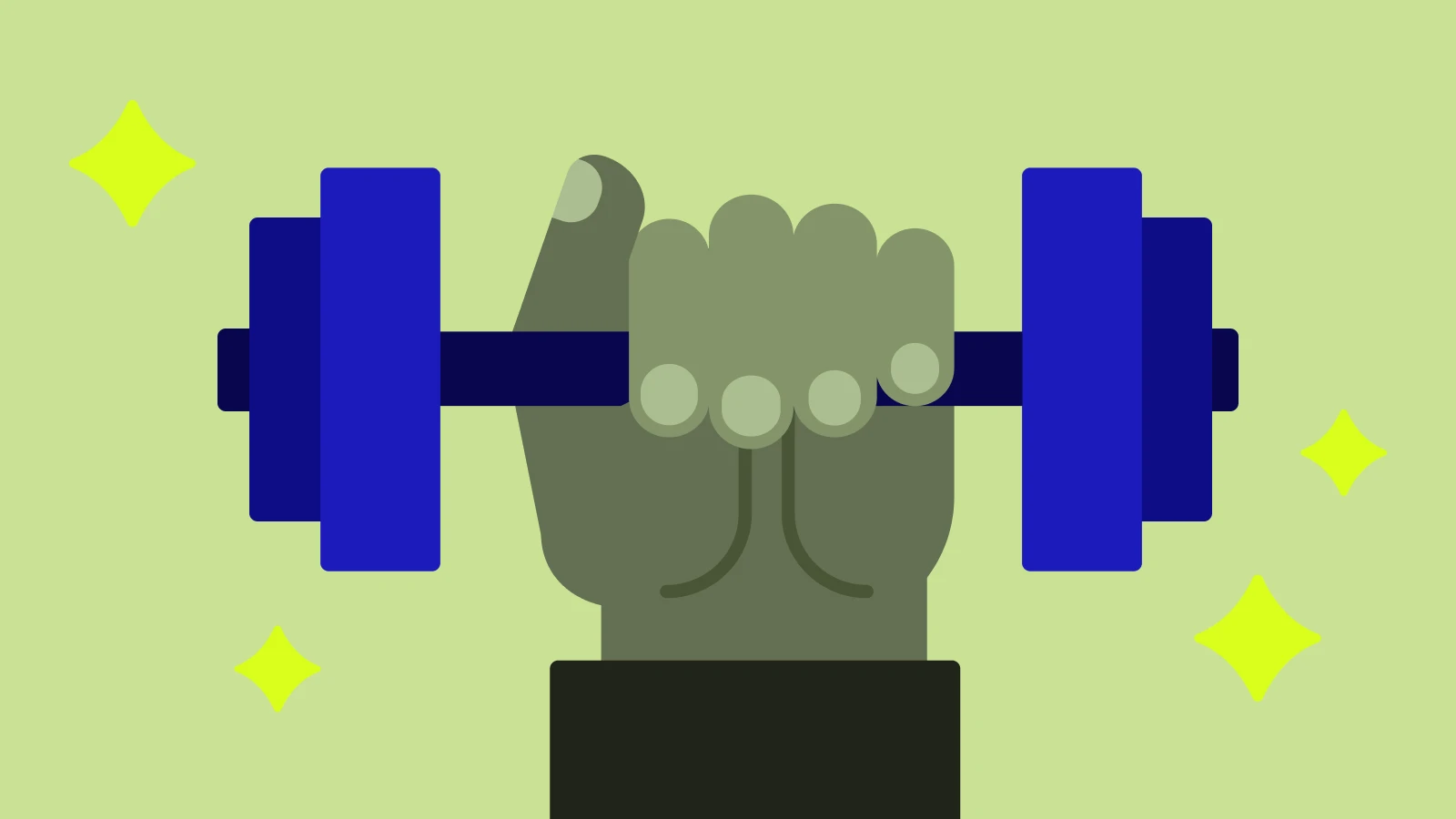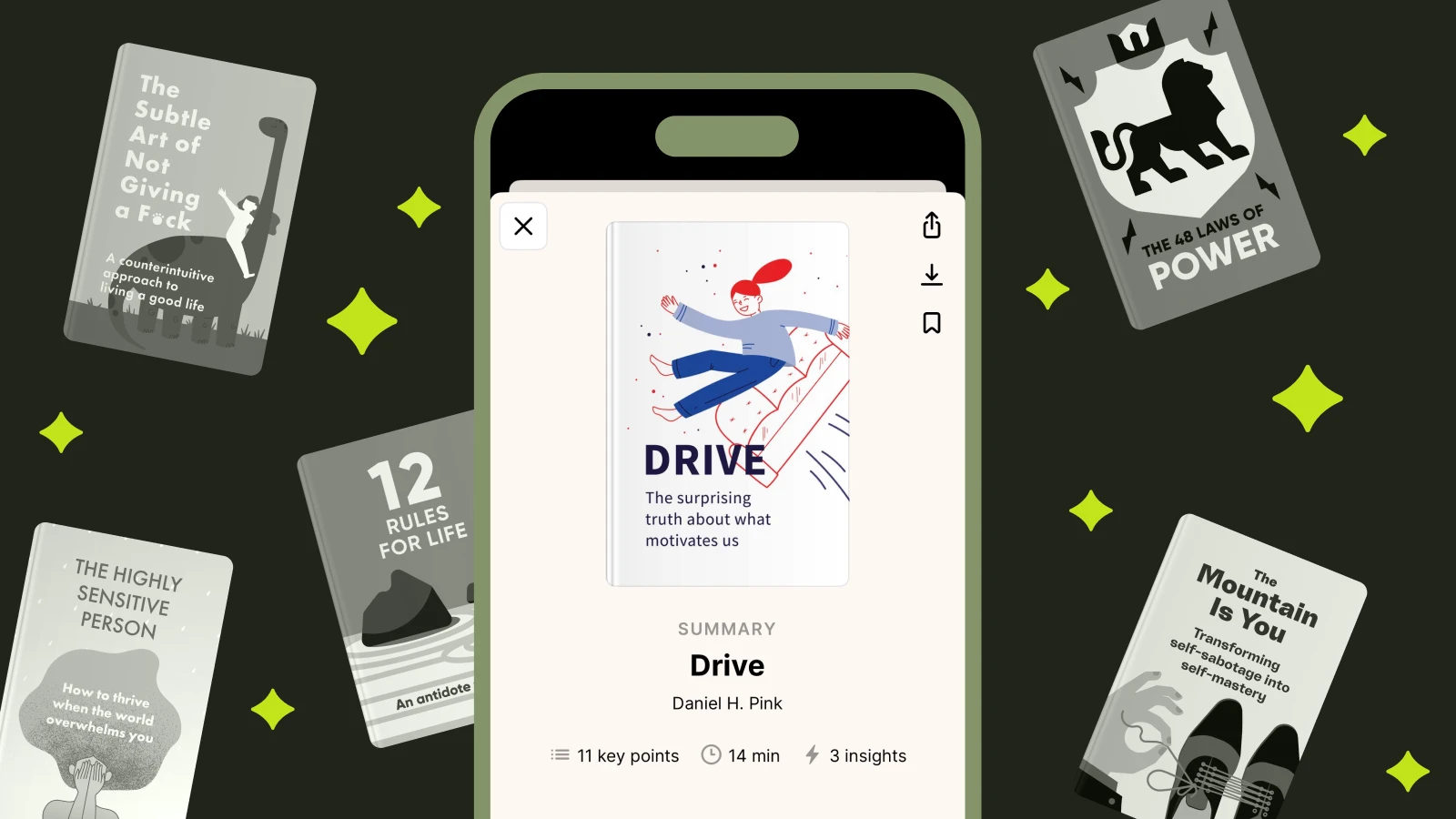Every year, the world starts life from a clean slate. Promises come from all over the world, but not all are realized. So, how can you set strong goals? How can you stay motivated on the way toward them? And, how should you act to be among the lucky ones who are satisfied with last year's results?
Setting goals provides direction in your life, helps reduce anxiety, and boosts self-confidence. Goals help you understand your desires, emotions, and plans and achieve what is essential. Personal goals affect your relationships with yourself and people, as well as your understanding of what you want in life.
Use this guide to brainstorm powerful goals tailored to the unique areas of your life that matter most.
In this article, you will learn:
How to set goals
Different types of goal ideas to make your life brighter
How to track your goals properly
How to integrate goals into your daily life
Plan SMART, achieve more
As James Clear writes in his book 'Atomic Habits,' you don't achieve goals by accident—you arrive at them through a system of daily habits. The path to a goal is movement from point A to point B. If the path is built correctly, you can overcome obstacles, reduce anxiety, and gain self-confidence. When you reach point B, you have energy and the opportunity to create new roadmaps.
To form a goal, you need to analyze it using five steps that correspond to the acronym (five letters of the SMART goals method's name):
S — Specific. What exactly do you want to achieve? Be specific, don't use general phrases. Instead of "Wake up earlier," try "Wake up every day at eight in the morning."
M — Measurable goals. By what criteria will you measure the achievement of the goal? Try, "Read 50 pages daily" instead of "Read more books."
A — Achievable goals. What skills and resources do you have to achieve the goal? It’s crucial to assess your workload and capabilities realistically. Instead of "Travel every month," try "Go to a neighboring city on the weekend."
R — Relevant. Why is this goal important to you? Goals are difficult to achieve when they’re dictated by trends or other people, not your values. Instead of "Becoming more confident," it could be "Start talking more actively with new colleagues."
T — Time-bound. A goal should have time frames. It’s essential to clearly and realistically determine by what date it needs to be achieved. Try "No alcohol/caffeine for a month," instead of "give up alcohol/caffeine."
All goals can be divided into long-term and short-term. For example, a yearly goal is long-term, and a monthly goal is short-term. Yet, short-term goals can bring you closer to long-term goals.

Tips for implementation and tracking the progress of your goal achievement
Achieving your goals is not just a matter of desire or luck, but a carefully thought-out process that requires a specific action plan and strategies. How often do your goals remain dreams due to the lack of a plan or a vague vision of how to achieve them?
When you write down your goals, they become concrete and tangible — writing them down forces you to think through all the aspects in more detail, making them more tangible and realistic.
A big goal can seem overwhelming if you don't break it down into smaller, achievable steps. Breaking your goals into sub-goals allows you to move forward gradually and see milestones that motivate you to keep going. In addition, each sub-goal becomes a more straightforward guide for your daily actions.
Milestones are key to achieving your big goal. They help you measure your progress and adjust your plan if necessary. These milestones indicate that you are on the right track. You can also use a free habit tracker printable to see your progress.
Short-term goal ideas
1. Gain 5,000 followers on social media
2. Shoot and post a video for 100,000 views
3. Learn a new language at level B2
4. Develop time management skills
5. Get a pet
6. Try a new hobby every month
7. Visit dance classes
8. Make a carpet using carpet embroidery
9. Reduce your screen time to three hours a day for personal needs
10. Visit a concert of your favourite band or singer
11. Try gardening
12. Create a design project for your home
13. Do some home improvements
14. Paint with watercolors
15. Complete a portrait photography course
16. Design and sew your dress
17. Go swimming two times per month
18. Learn to play tennis
19. Make donations to education in a developing country
20. Go on a retreat for self-discovery
21. Read the New Testament and form your opinion
22. Write a book
23. Learn to play a musical instrument
24. Read 100 books
25. Grow a tree or a whole garden
26. Swim with dolphins
27. Learn to ride a horse
28. Fly in a hot air balloon
29. Learn one martial art
Adventure goal ideas
30. Complete an endurance race
31. Run a marathon
32. Hike the nearest nature trails
33. Live in an unfamiliar country for two or more months
34. Have dinner at a top restaurant in the city
35. Go to a theme park
36. Take a water adventure
37. Climb a mountain
38. Travel your country
39. Enjoy an all-inclusive vacation
40. Take a cruise ship vacation
41. Go on an island getaway
42. Try a mission trip
43. Take a pilgrimage trip
Goal examples for work
44. Challenge yourself to learn three new skills this year
45. Listen to at least one podcast or book summary every day on the topic of development and improving leadership skills
46. Pass an online course related to your professional development
47. Create and fill out your LinkedIn page so that potential employers can find you
48. Speak in front of an audience of 30+ people to improve your public speaking skills
49. Read one non-fiction book every month
50. Build up a "financial cushion" in six months
51. Get a new job or promotion by the end of the year
52. Explore two new professional areas that interest you
53. Get a promotion or discuss a development plan within the next six months
54. Start public communication, perhaps using social media, a blog, or interviews
Health and well-being goal inspirations

55. Establish a morning routine
56. Start regular self-care for your body and face
57. Develop your work-life balance
58. Improve your mental health to enjoy life
59. Do a full body check-up
60. Find a mentor
61. Take a psychotherapy course
62. Discover your spirituality
63. Learn to cook healthy meals
64. Start meditating to reduce stress
65. Understand yourself
66. Try exotic foods from different world cuisines
67. Learn to do massage
68. Eat only home-cooked food for a whole week
69. Check your body for vitamin and microelement deficiencies
70. Identify excess body fat and lose it
71. Consult a cosmetologist and choose professional care based on your skin type
72. Go to bed by 11:00 pm for 30 days
73. Practice breathing techniques or meditation for five minutes per day
74. Avoid coffee for 30 days and check your energy levels
Financial goals to set
75. Save up a certain amount of money
76. Pay off all your credit card debts
77. Improve your financial skills to manage your resources better
78. Invest in your future
79. Learn a financial tool to manage your money
80. Develop a good credit rating
81. Own an investment property
82. Increase your income
83. Plan your retirement
84. Be an expert in your industry
85. Create multiple streams of income
86. Buy your first home
87. Control your finances. Record your expenses and income for six months
88. Save 20% of your income every month
Relationship and social goals suggestions
89. Have a date night with a loved one weekly
90. Spend time with your children and play their favorite games
91. Create family traditions to strengthen the bonds between you
92. Have a personal meeting with a family member every week
93. Work on your communication skills
94. Volunteer in a nursing home
95. Try gratitude journaling to feel more joy and satisfaction
96. Hold regular family gatherings
97. Do one act of kindness every week
98. Trace your family tree
99. Organize a board game night
100. Have a picnic with your neighbors
101. Go on bike rides with friends on summer weekends
Turn your goals into daily habits — use lessons from bestselling books

Many people can dream, set goals, or even write them down in their favorite notebooks or mood boards. Of course, not everyone takes real steps toward achieving them, but paying attention to the advice in motivational books can be invaluable.
'The Power of Habit ' by Charles Duhigg
Habits are the basis for achieving goals. Duhigg shows that power is not in motivation, but in the systems you create. If your goal is to lose weight, the key is not to dream of a perfect figure, but to form healthy eating and exercise habits.
'Drive' by Daniel H. Pink
Goals work when they are supported by intrinsic motivation. Pink says, "Real drive comes from within." That is, goals should be based not only on external rewards (money or status) but also on what is meaningful to you. Choose goals that excite you, and passion will give you the strength to reach the finish line.
'Mindset' by Carol S. Dweck
'Mindset' is one of the most important books about achieving goals through the power of mindset. How you view yourself and your abilities directly affects whether you reach your goal or give up halfway. There is a type of thinking called a growth mindset, and this means you believe in developing through effort, learning, and mistakes.
People with a growth mindset focus on progress, not perfection. They perceive goals as a path to development, not as proof of their worth.
'Atomic Habits' by James Clear
"Habits are the compound interest of self-improvement."
'Atomic Habits' is one of the most practical books on achieving goals. However, Clear's main idea is that success is not achieved by setting goals but through daily systems and habits. To achieve a goal, focus not only on it but also on the system of habits you build every day. Over time, minor improvements repeated daily (even by 1%) give colossal results.
'Make Your Bed' by Admiral William H. McRaven
"If you want to change the world, start off by making your bed."
Start with a small victory. Make your bed every morning — even on the weekend. It's your first completed action of the day, and it helps keep the momentum going even on tough days. And that goes for any goal. Build your plan for the day, week, and month.
'The ONE Thing' by Gary Keller, Jay Papasan
'The ONE Thing' is a powerful tool for those who want to achieve goals by focusing on what is most important. Identify one key action for each goal, then block time for "one thing" daily. For example, you have a goal to improve your health. So, instead of diets, fitness programs, and tracking apps, simply drink eight glasses of water a day. Keep a daily tracker to accomplish your specific goal and make it a habit.
Reach your goals faster with Headway
Setting goals is vital. Goals, like dreams, give strength and motivation to move forward in life, inspire change, broaden horizons, and simply make you happy. It applies to personal or social goals.
For deeper insights on goal achievement and motivation, download the Headway app. Headway offers quick, actionable insights from the best non-fiction books to help you define career milestones, build healthier habits, and pursue personal growth. The app will select book summaries just for you.
Imagine you've set a goal to improve your time management. Instead of spending hours searching for advice, Headway instantly recommends book summaries like 'Eat That Frog!' by Brian Tracy. In just 15 minutes, you'll learn proven strategies to beat procrastination, prioritize better, and stick to your plan.
So, let's take small steps toward your dreams with the Headway app.
Frequently Asked Questions
What types of goal ideas can help me grow?
A balance of different life areas is important. Personal development builds self-esteem, flexible thinking, and the ability to change. Professional development provides stability, self-realization, and confidence in the future. Financial literacy relieves stress and gives freedom of choice. Health gives energy, endurance, and clarity of thinking. Finally, relationships fill you with inner strength and build deep connections.
What system should I use to plan goals and to‑dos?
Use the SMART system to set clear goals. The ONE Thing method helps you avoid scattering, so you use your main goal, or your pyramid of goals, to see what you’re working toward every day.
How can I handle obstacles and stay motivated?
Know your motivation and why you are doing it. Leave a reminder in a visible place and break your big dream into small steps (e.g., if you want to write a book, write one page every day). Mark your progress in a tracker, and celebrate achievements. And, importantly, communicate with like-minded people who can support you.
How can I create accountability for my goals?
To keep yourself accountable for your goals, you can post them on social media, tell a friend, or keep a goal journal. You can also team up with a friend, colleague, or find an online support group to report back on your progress and failures each week. Schedule a specific block of time on your calendar to work on your goal.
What's the difference between product goals and process goals?
Product goals are specific results you want to achieve in the end — the "fruits of your labor." Here, the focus is on the end result, impact, or change. Process goals are goals related to the actions, habits, and steps that lead to the product. Within this, the focus is on regular actions and process improvement.













